Tree landscaping transforms outdoor spaces into stunning natural environments that provide beauty, function, and environmental benefits year-round. Whether you're seeking privacy, shade, ornamental appeal, or seasonal interest, strategic tree placement creates compelling landscape designs that enhance property value while supporting local ecosystems. From formal arrangements to naturalistic settings, trees serve as architectural elements that define spaces, frame views, and establish garden structure. The key lies in selecting appropriate species for your climate and designing cohesive themes that integrate seamlessly with existing landscape features. These comprehensive tree landscaping concepts offer diverse approaches to creating outdoor spaces that evolve beautifully through seasons while meeting practical needs.
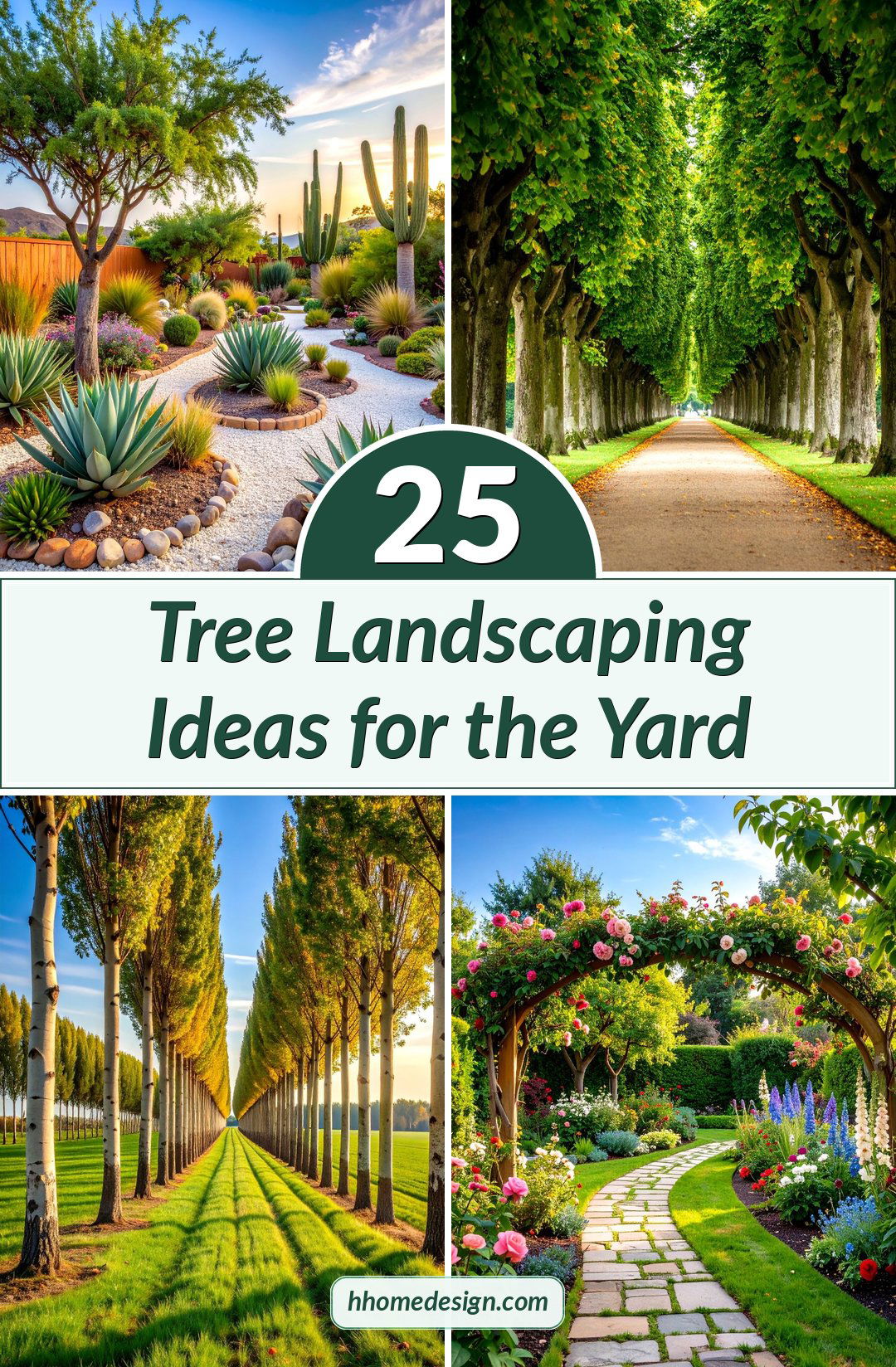
1. Mediterranean Olive Grove Courtyard Design
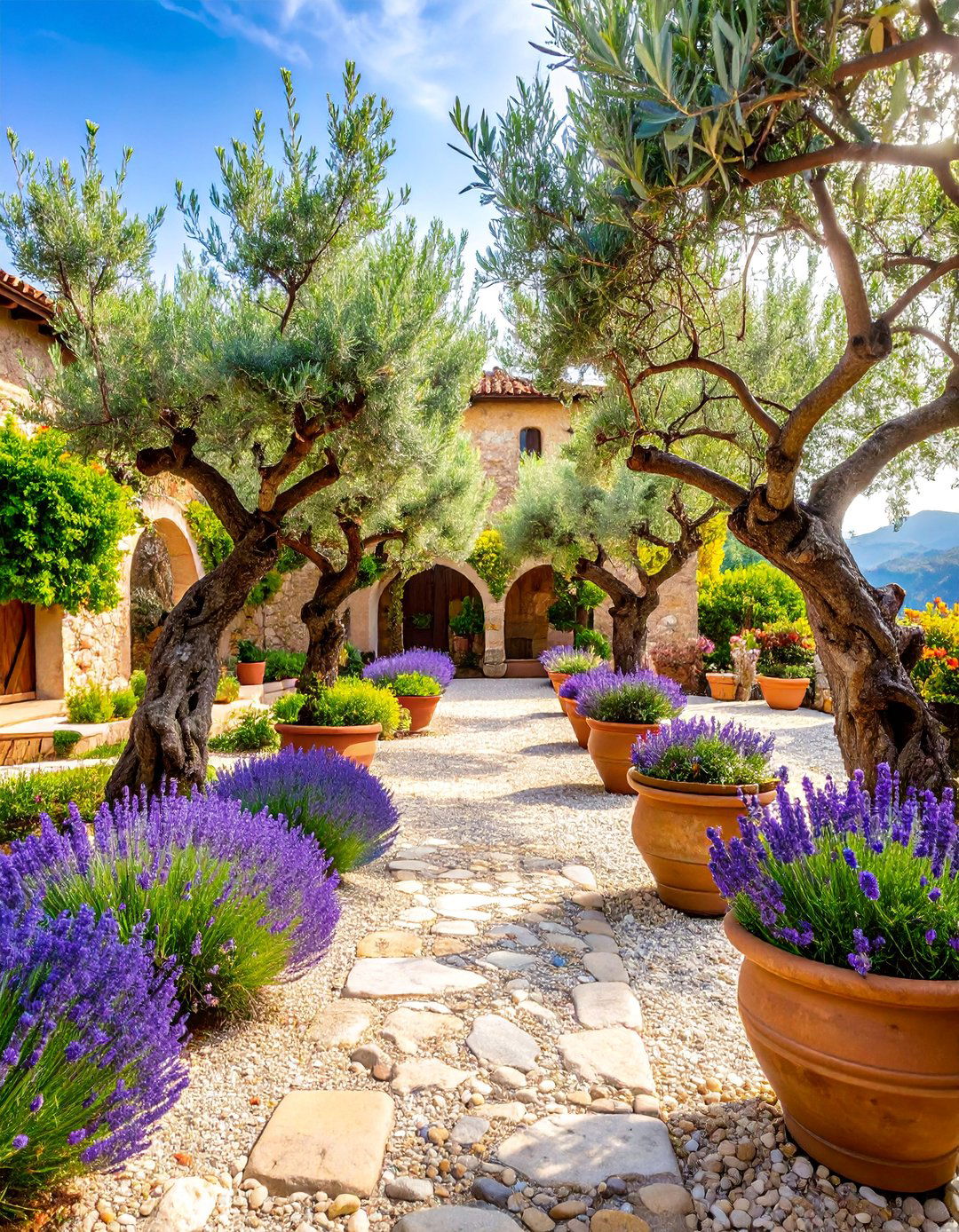
Create an authentic Mediterranean atmosphere by establishing clusters of olive trees in gravel-mulched beds surrounded by drought-tolerant herbs and succulents. This design features three to five mature olive trees positioned asymmetrically around a central gathering space, with their silvery foliage providing filtered shade and visual interest. Complement the olives with aromatic lavender, rosemary, and santolina planted in irregular drifts between the trees. Terra cotta containers filled with citrus trees add moveable color accents throughout the space. Weathered stone pathways wind between plantings, while a simple water feature creates a focal point. The overall effect combines rustic charm with sophisticated restraint, perfect for warm climates.
2. Japanese Maple Zen Garden Sanctuary

Design a contemplative space centered around carefully selected Japanese maples with varying foliage colors and forms arranged in harmonious composition. Position a weeping red maple as the primary focal point, flanked by upright varieties in complementary burgundy and green tones. Create layers beneath with shade-loving hostas, ferns, and moss-covered stones to establish a serene understory. Incorporate a gently curving pathway of flat stepping stones that encourages slow, mindful movement through the space. Add subtle lighting to highlight the maples' architectural branching and seasonal color changes. Bamboo screens provide privacy while maintaining the authentic Japanese aesthetic. This design celebrates seasonal transformation and creates peaceful meditation space.
3. Formal Evergreen Privacy Screen Framework

Establish stately privacy using precisely spaced evergreen trees in geometric arrangements that provide year-round screening while maintaining elegant formality. Plant Thuja Green Giant or Italian Cypress in straight lines with consistent spacing, creating living walls that define property boundaries or separate outdoor rooms. Underplant with low-growing boxwood hedges for additional structure and visual weight at ground level. Install uplighting to illuminate the trees' vertical forms during evening hours, extending their impact beyond daylight. Incorporate seasonal color through planters filled with annuals positioned at regular intervals along the screen. The formal arrangement requires minimal maintenance while delivering maximum privacy and sophisticated curb appeal throughout all seasons.
4. Native Wildlife Habitat Tree Grove

Create a thriving ecosystem by clustering native deciduous trees that support local birds, butterflies, and beneficial insects while providing natural beauty. Select region-appropriate species like oak, maple, or dogwood trees planted in naturalistic groupings that mimic forest edge conditions. Design irregular planting beds around tree clusters, filling them with native wildflowers, berry-producing shrubs, and ornamental grasses that provide food and shelter for wildlife. Include bird houses and shallow water features to enhance habitat value. This design requires minimal irrigation once established and provides four-season interest through flowering, fruiting, fall color, and winter structure. The naturalistic approach creates a low-maintenance landscape that actively contributes to local biodiversity.
5. Fruit Orchard Backyard Design
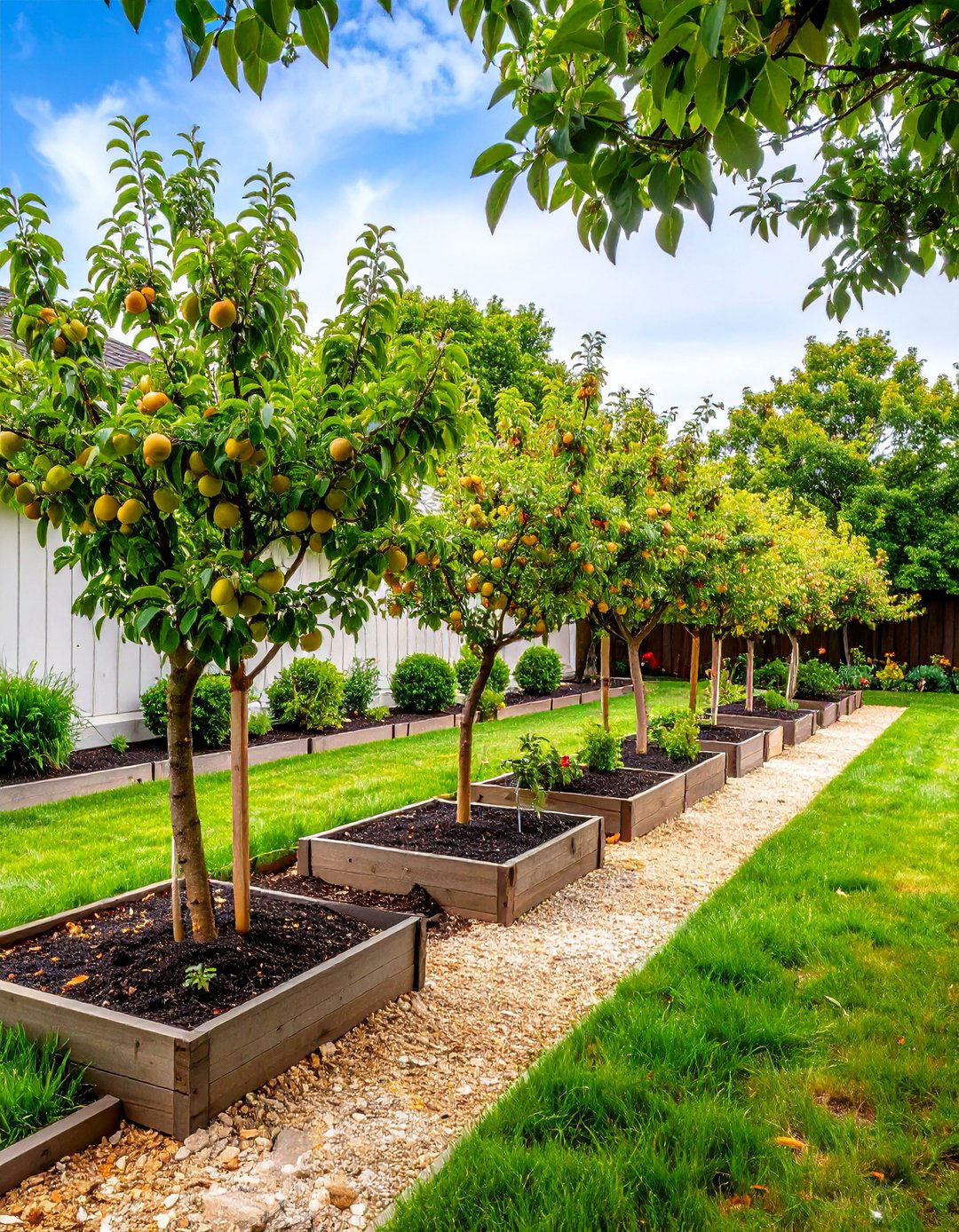
Transform available yard space into a productive and beautiful fruit-growing area by arranging dwarf fruit trees in organized rows or clusters for easy maintenance and harvest. Design raised planting beds or create a grid pattern with apple, pear, cherry, and plum varieties selected for your climate zone. Install drip irrigation throughout the orchard area and cover pathways with wood chips or gravel for clean walking surfaces. Companion plant with herbs like comfrey and chives that benefit fruit tree health while providing additional harvest opportunities. Add trellises for climbing berries and include storage for harvest baskets and pruning tools. This functional landscape combines aesthetics with productivity, offering fresh fruit while creating an organized, cottage-style garden atmosphere.
6. Flowering Tree Seasonal Parade
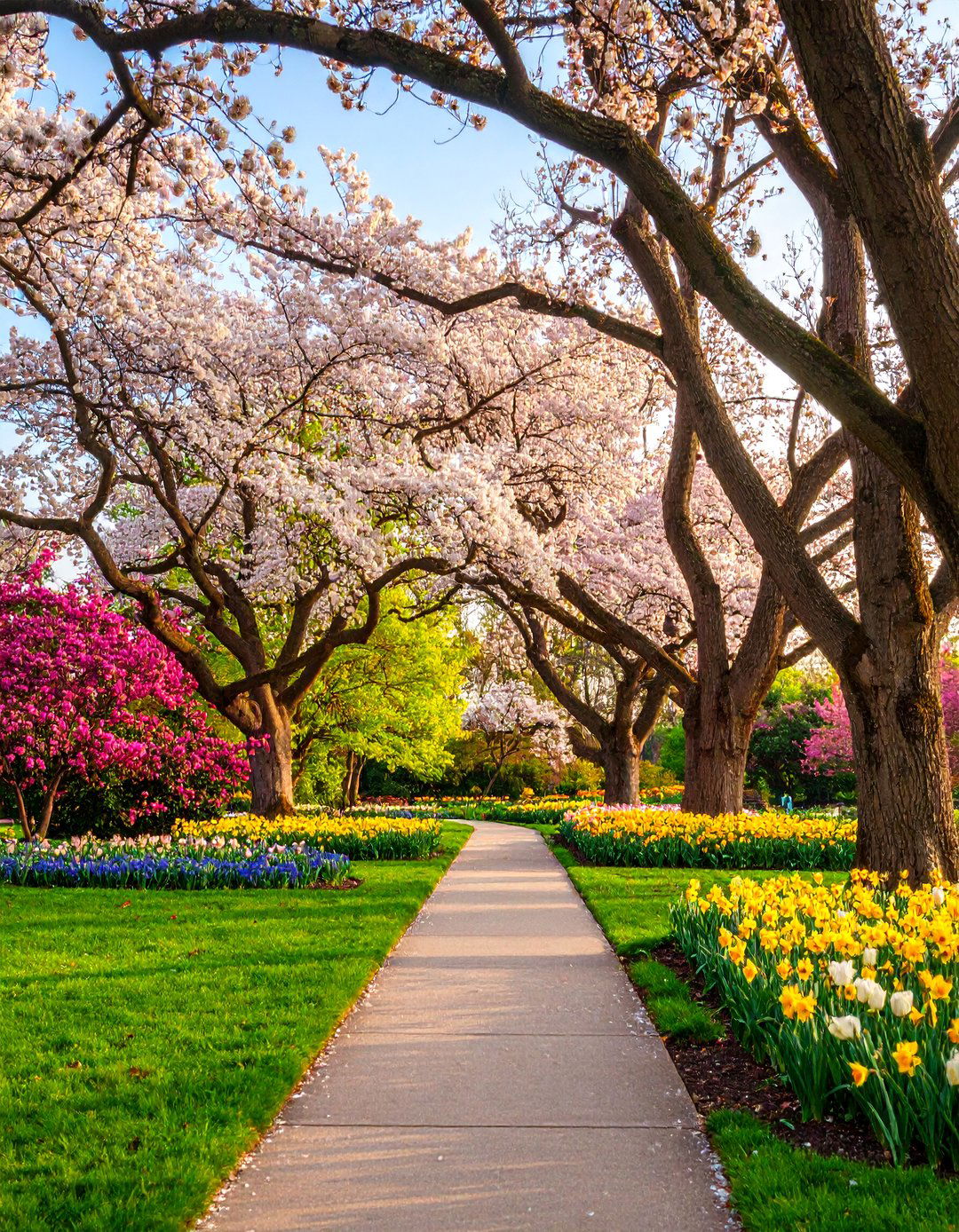
Design a succession of blooming trees that provide continuous flower displays from early spring through late summer by carefully selecting varieties with staggered bloom times. Begin with early-flowering trees like serviceberry and redbud, followed by cherry and magnolia for mid-spring color, then transition to later varieties like catalpa and crape myrtle for summer interest. Arrange trees in layered groupings where their canopies complement rather than compete with each other. Plant spring bulbs and summer perennials beneath to extend the flowering theme throughout the ground plane. This design creates a garden focused on celebrating seasonal transitions through spectacular floral displays that attract pollinators and provide fragrance.
7. Shade Garden Canopy Paradise
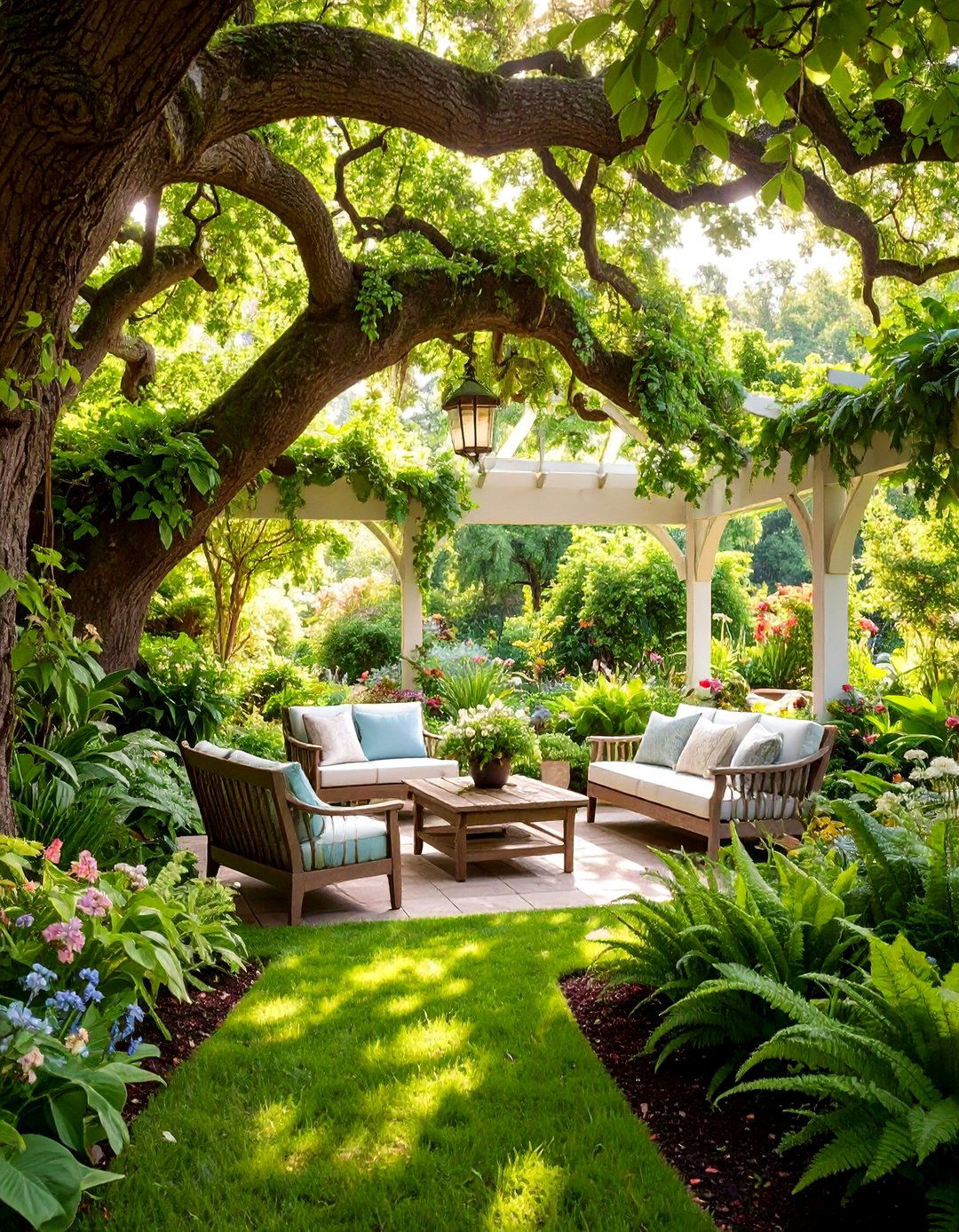
Establish large canopy trees to create cool, comfortable outdoor rooms filled with shade-loving plants that thrive in filtered light conditions. Position majestic specimens like oak, maple, or sweetgum trees to provide substantial overhead coverage, then develop the understory with layers of shade perennials, ferns, and flowering shrubs. Create winding pathways that invite exploration through different microclimates and seasonal displays. Include comfortable seating areas positioned to take advantage of cooling shade and garden views. Add features like wind chimes or small water elements that enhance the sensory experience. This design transforms hot, sunny areas into cool retreats perfect for relaxation and entertaining during warm weather.
8. Modern Sculptural Tree Statement
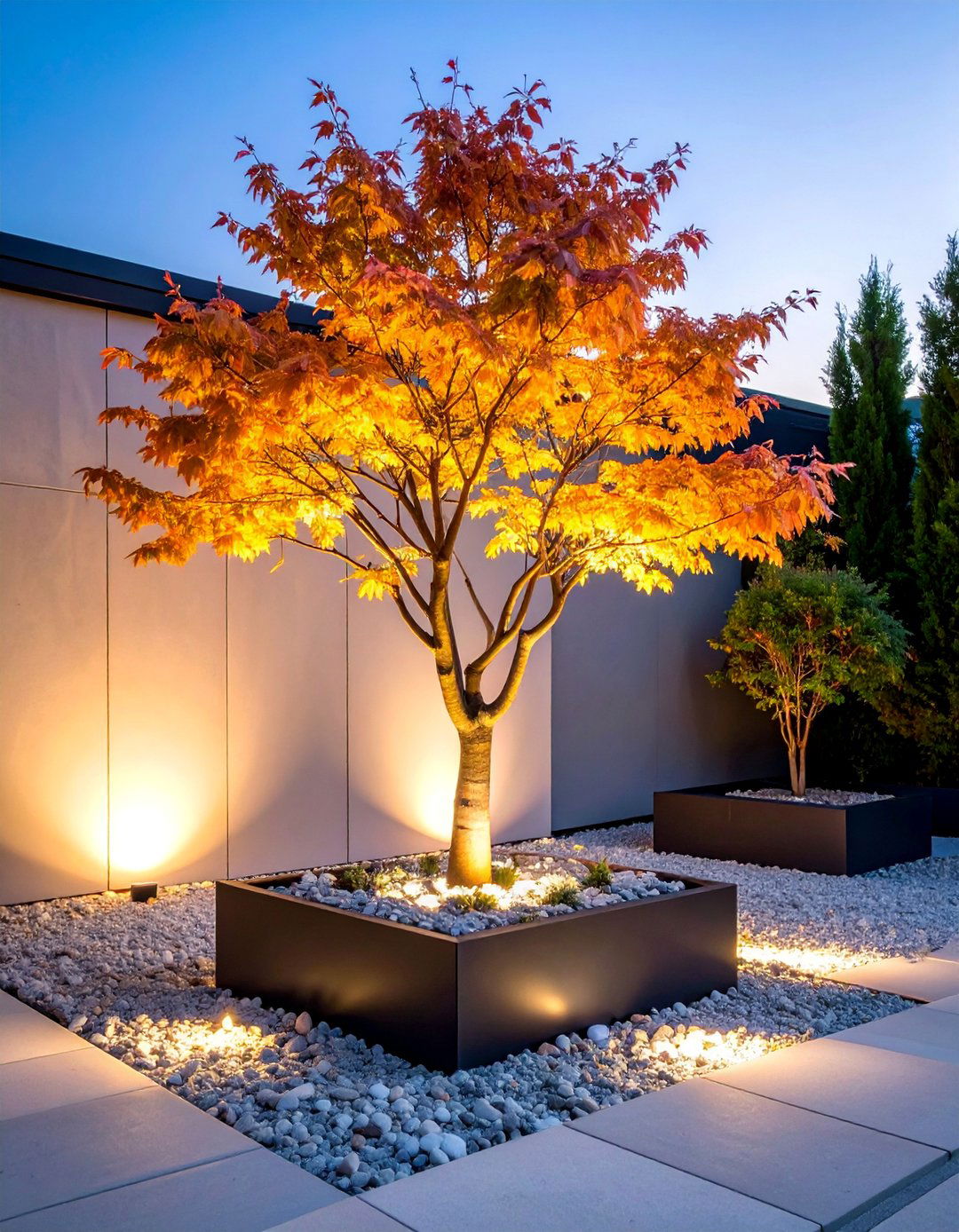
Create contemporary outdoor art using architecturally striking trees with unique forms, textures, or growth habits that serve as living sculptures in minimalist landscape settings. Select specimen trees like paper bark maple, contorted filbert, or weeping blue atlas cedar for their distinctive characteristics, then position them prominently against simple backgrounds of smooth gravel or architectural surfaces. Eliminate competing elements to focus attention entirely on the trees' natural forms and seasonal changes. Use dramatic uplighting to transform the trees into nighttime focal points. Complement with modern hardscaping materials like steel planters or concrete benches. This approach treats trees as artistic elements that provide year-round visual interest.
9. Cottage Garden Tree Framework

Design charming informal landscapes by combining flowering and fruiting trees with abundant perennial gardens that evoke traditional English cottage style. Integrate apple, pear, and ornamental cherry trees throughout mixed borders filled with roses, delphiniums, hollyhocks, and other cottage garden favorites. Allow plants to self-seed and intermingle naturally while maintaining enough structure to prevent chaos. Include climbing roses or clematis trained up tree trunks for additional vertical interest. Create meandering pathways using natural materials like flagstone or brick that invite leisurely exploration. Add rustic garden structures like arbors or picket fences to complete the romantic, old-world atmosphere that celebrates abundance and informality.
10. Evergreen Foundation Landscape Structure

Establish year-round structure using strategically placed evergreen trees that provide consistent color, texture, and form regardless of seasonal changes. Create a framework of different evergreen species varying in size, shape, and foliage color, from columnar junipers to spreading yews to pyramidal spruces. This permanent structure serves as a backdrop for seasonal plantings and provides visual anchors throughout the landscape. Position evergreens to frame views, define spaces, and create interest through contrasting forms and textures. The reliable presence of evergreens ensures the landscape maintains appeal even when deciduous plants are dormant, while requiring minimal maintenance once established.
11. Windbreak Protective Tree Barrier
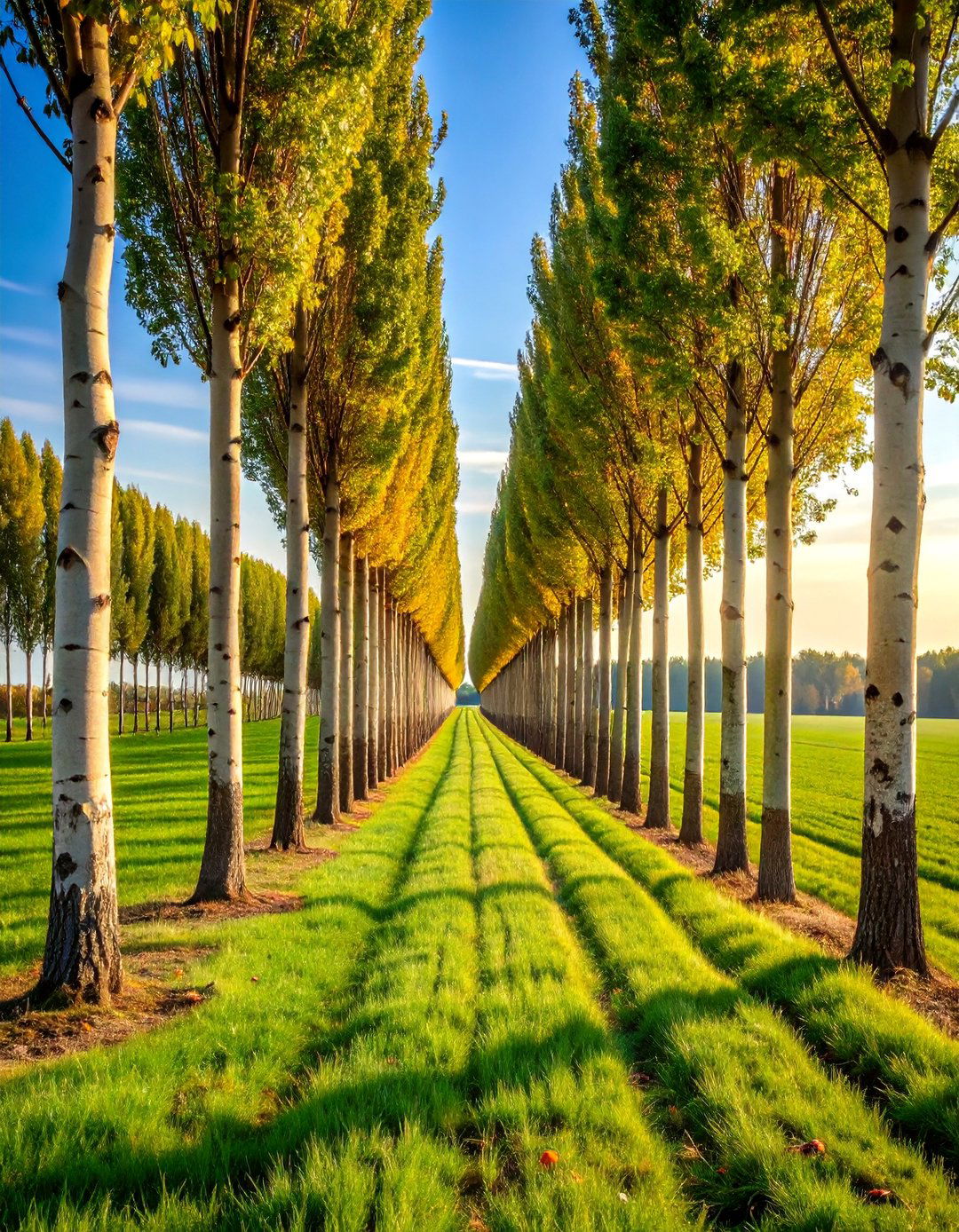
Design functional barriers using fast-growing trees arranged to protect property from harsh winds while creating beneficial microclimates for other plantings. Select hardy species like poplar, willow, or pine trees planted in multiple rows with staggered placement for maximum wind protection. Create different heights within the windbreak to handle winds at various levels and improve overall effectiveness. Include some flowering or fruiting varieties to add seasonal interest beyond the primary protective function. Design pathways through or around the windbreak to maintain accessibility while preserving wind protection. This utilitarian landscape feature can dramatically improve growing conditions throughout the property while reducing energy costs and creating habitat.
12. Waterside Tree Reflection Garden

Enhance properties near water features by selecting and arranging trees that create stunning reflections while tolerating moisture-rich growing conditions. Choose species like weeping willow, bald cypress, or river birch that thrive in wet soils and provide graceful forms that mirror beautifully in water surfaces. Position trees at strategic points around pond or stream edges to maximize reflection potential while allowing access for maintenance and enjoyment. Include moisture-loving perennials and ornamental grasses in the understory to complete the waterside ecosystem. Add seating positioned to appreciate both direct tree views and their reflected images. This design creates a serene, contemplative atmosphere that celebrates the interaction between water and vegetation.
13. Autumn Color Spectacular Display
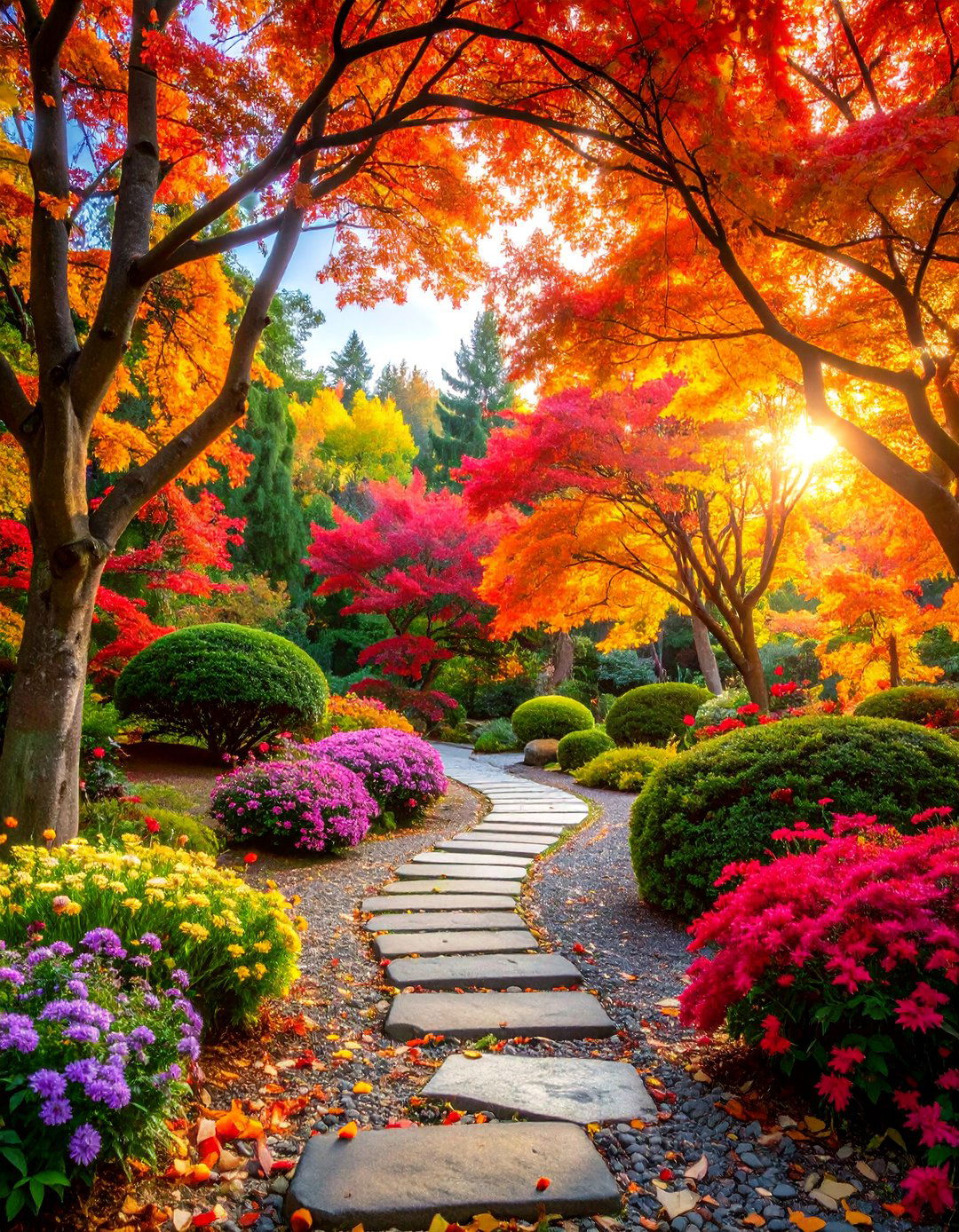
Create dramatic fall landscapes by selecting and grouping trees specifically chosen for their exceptional autumn foliage in complementary or contrasting color schemes. Combine maples for brilliant reds and oranges with ginkgos for golden yellows and sweetgums for purple tones to create a painter's palette of fall color. Position trees where their autumn display can be appreciated from multiple viewpoints, including interior windows and outdoor gathering areas. Design pathways that lead through the collection, allowing close appreciation of different varieties and their unique characteristics. Plant spring bulbs and asters beneath for additional seasonal interest. This design celebrates one of nature's most spectacular seasonal transformations.
14. Screening Tree Room Dividers

Use trees as natural walls to create distinct outdoor rooms and zones within larger landscape spaces without sacrificing openness or blocking desirable views. Select trees with appropriate mature sizes and growth habits to provide separation while maintaining visual flow between areas. Consider using columnar varieties for narrow spaces or spreading trees for broader separations. Create partially screened areas that provide privacy while maintaining connection to the broader landscape. This technique allows large properties to feel more intimate while preserving the sense of spaciousness. Include different tree species to add variety and seasonal interest to the living room dividers.
15. Specimen Tree Focal Point Drama

Establish commanding focal points using single, spectacular trees positioned to draw attention and anchor landscape compositions with their extraordinary beauty or unique characteristics. Select trees with outstanding features like dramatic flowering, unusual bark, weeping forms, or exceptional size that command attention throughout seasons. Position the specimen tree at visual termination points, in the center of open areas, or where pathways converge to maximize impact. Design the surrounding landscape to complement and enhance the specimen without competing for attention. Include lighting to extend the tree's impact into evening hours. This approach treats exceptional trees as natural sculptures that provide enduring landscape drama.
16. Urban Small Space Tree Solutions
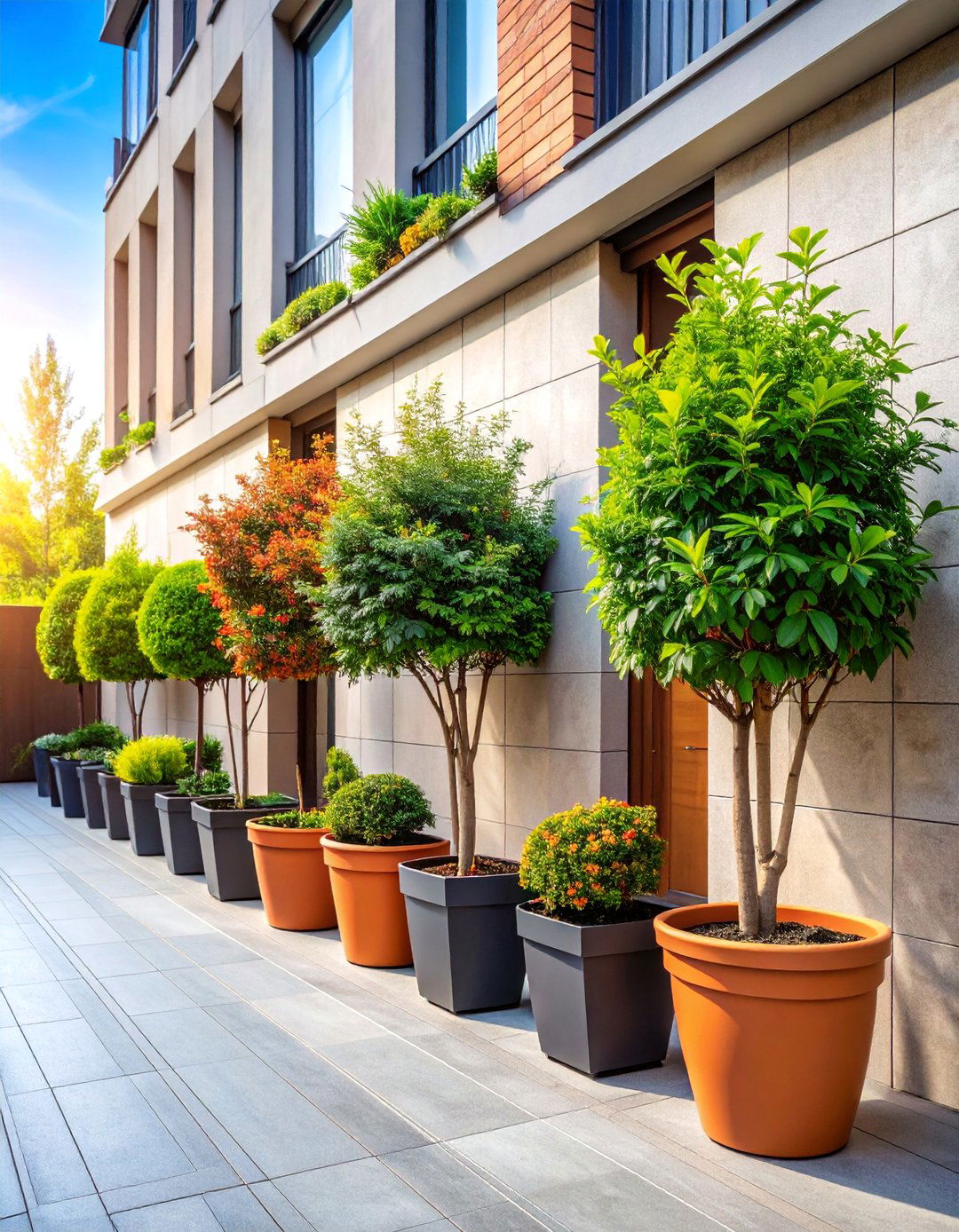
Maximize limited urban spaces by selecting compact trees and designing efficient layouts that provide maximum benefit within confined areas using creative placement and multi-functional approaches. Choose dwarf or columnar varieties that fit small lots while providing shade, privacy, and seasonal interest. Use container planting for flexibility and include espaliered trees against walls to save space while adding vertical interest. Design multi-level planting schemes that make efficient use of available ground area. Include fold-away furniture and storage solutions that work around tree placement. This approach proves that even the smallest urban spaces can accommodate meaningful tree plantings that enhance livability and connection to nature.
17. Xeriscape Drought-Tolerant Tree Gardens

Create water-wise landscapes using drought-tolerant trees combined with succulents, ornamental grasses, and other low-water plants that thrive in arid conditions while providing beauty and function. Select native or adapted species like mesquite, palo verde, or oak trees that require minimal irrigation once established. Design gravel or decomposed granite pathways between plantings and use mulch to conserve soil moisture. Include sculptural agaves, colorful desert plants, and ornamental rocks to create visually striking compositions. This sustainable approach reduces water usage while creating landscapes that celebrate the beauty of arid environments and require minimal maintenance once established.
18. Pollinator Paradise Tree Gardens

Design landscapes that support bees, butterflies, and other beneficial insects by selecting flowering trees and complementary understory plants that provide nectar sources throughout growing seasons. Choose trees like basswood, tulip poplar, or native cherries that offer abundant flowers followed by plants that extend blooming periods. Create diverse habitat through varied plant heights, textures, and bloom times while avoiding pesticide use. Include water sources and nesting sites to support complete pollinator life cycles. Add interpretive elements to educate about pollinator importance and conservation. This environmentally beneficial design approach creates beautiful landscapes while actively supporting ecosystem health and biodiversity.
19. Multi-Season Interest Tree Collections
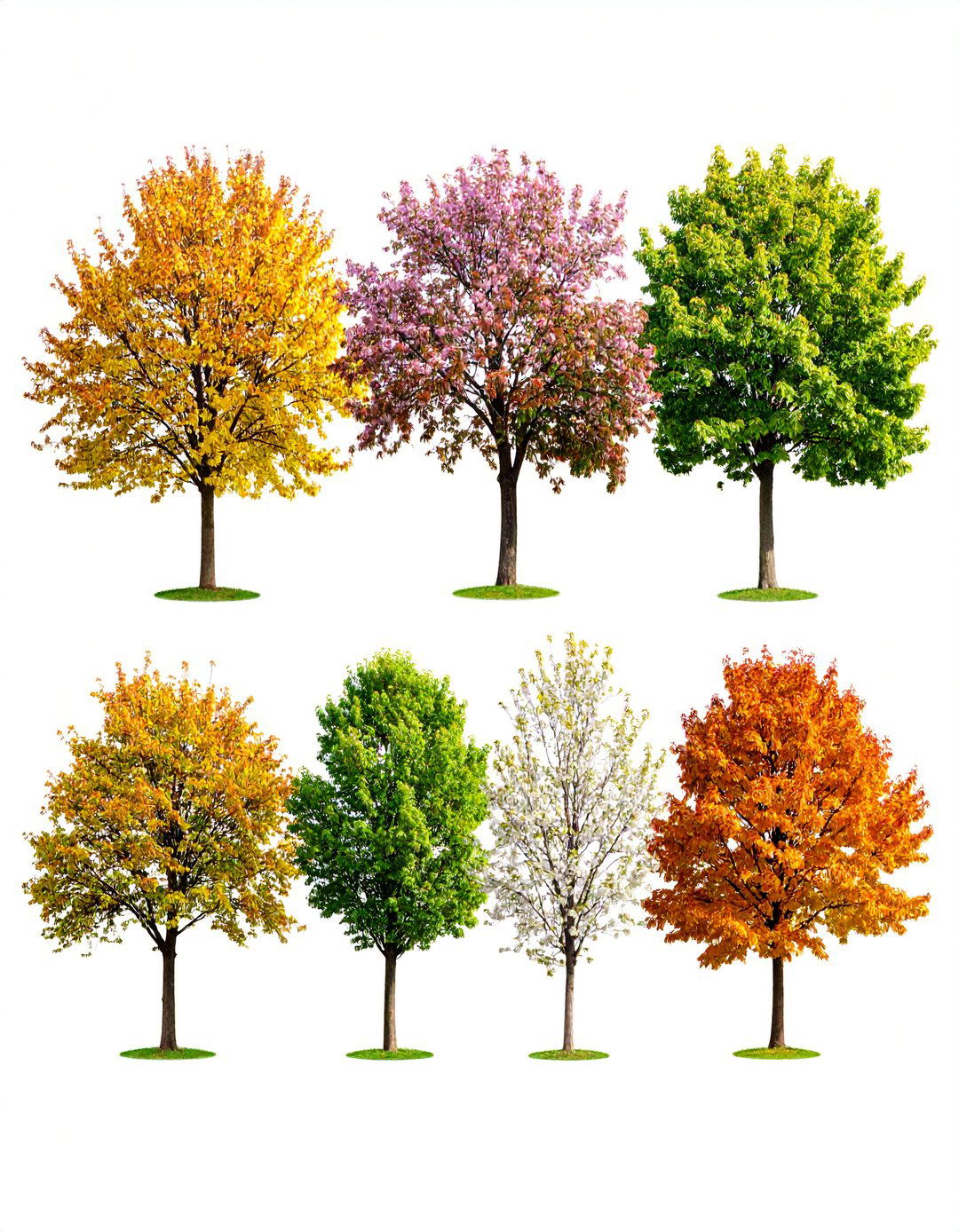
Develop landscapes that provide compelling visual appeal throughout all four seasons by combining trees selected for their varied seasonal characteristics and designing compositions that highlight different features as seasons progress. Include trees with spring flowers, summer foliage, autumn color, and winter structure or bark interest. Position varieties so their peak seasons complement each other and ensure something spectacular is always visible. Plan pathways and viewpoints to showcase seasonal changes and include lighting to extend winter interest. Add evergreen elements for consistent structure and incorporate seasonal containers for additional flexibility. This comprehensive approach ensures the landscape remains engaging and beautiful regardless of season.
20. Formal Allée Tree Corridor

Create grand, formal landscapes using matched trees planted in precise rows that form impressive corridors leading to focal points or connecting different landscape areas with classic European garden elegance. Select uniform species like London plane trees, lindens, or hornbeams planted at consistent spacing and maintained with regular pruning to preserve formal symmetry. Design the allée to frame important views or lead toward significant features like entrances, sculptures, or distant landscapes. Include understory plantings that complement the formal structure without competing for attention. This classical approach creates dramatic landscape architecture that provides shade, structure, and ceremonial grandeur while requiring careful maintenance to preserve the intended formal effect.
21. Grove Cluster Naturalistic Plantings
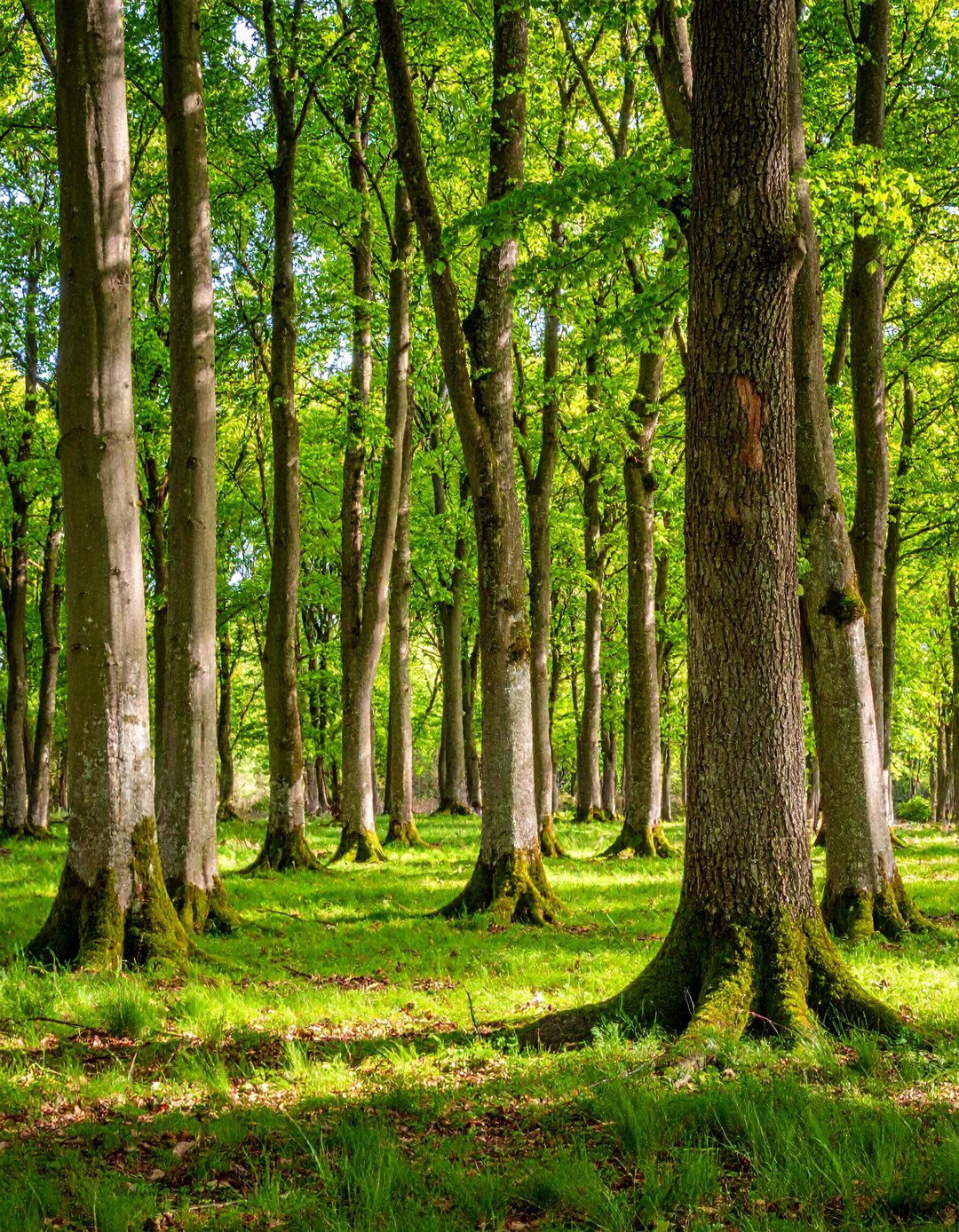
Develop naturalistic tree groupings that mimic forest patterns while providing screening, habitat, and seasonal beauty through informal arrangements that appear naturally occurring rather than designed. Plant trees in irregular clusters with varied spacing that creates naturalistic edges and openings similar to woodland clearings. Include trees of different ages and sizes to simulate natural forest succession and development. Design informal pathways that curve naturally through the grove and include native understory plants that support local wildlife. This approach creates low-maintenance landscapes that provide environmental benefits while appearing effortlessly natural and requiring minimal ongoing intervention.
22. Espalier Artistic Tree Training
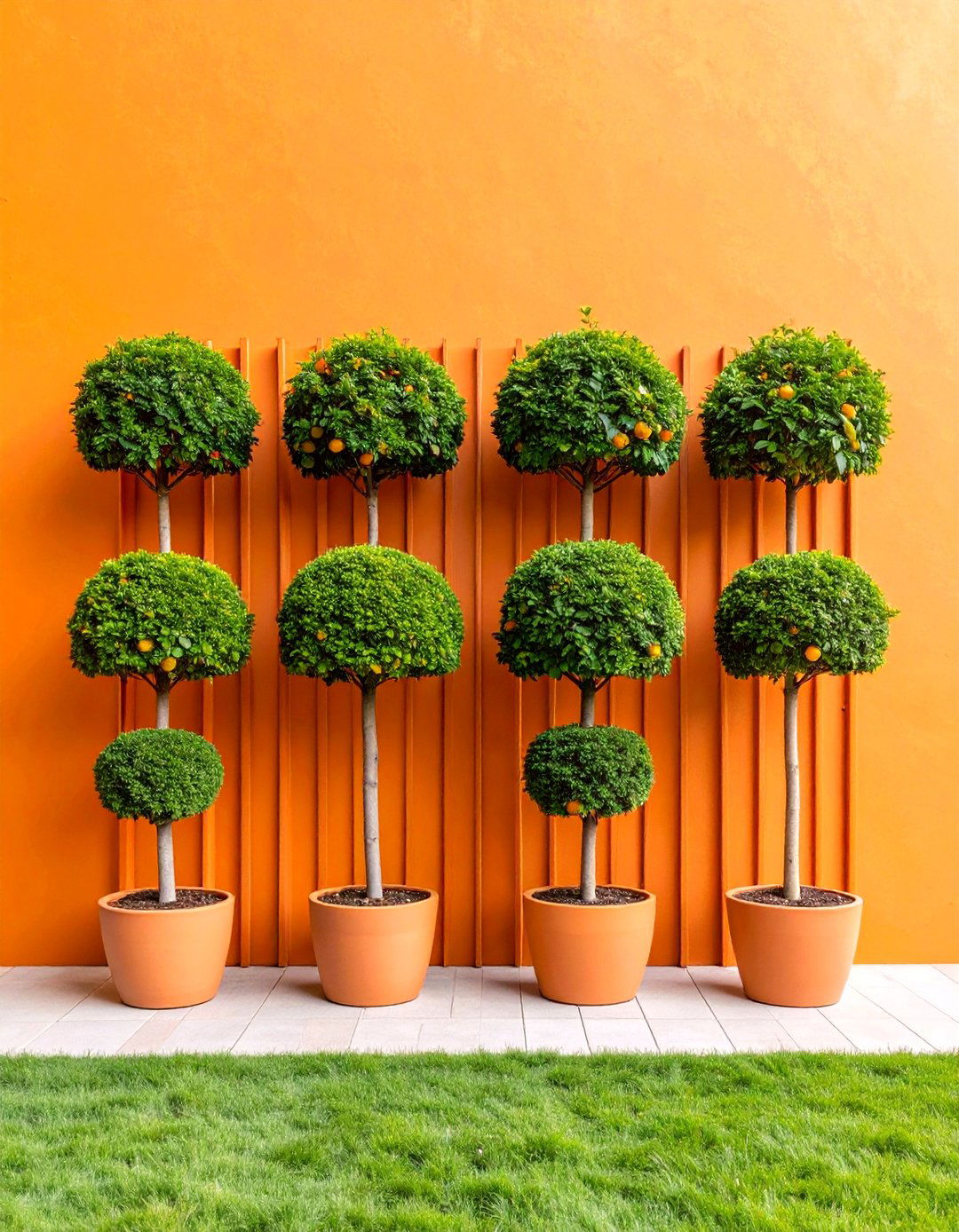
Transform limited wall space into productive and beautiful displays by training fruit trees into decorative flat patterns against fences, walls, or trellises using traditional European techniques. Select appropriate varieties like apple, pear, or fig trees and train them into formal patterns such as fans, cordons, or Belgian fences. Design support structures that complement architectural elements while providing adequate growing space. Include seasonal understory plantings that enhance the display without interfering with tree maintenance. This space-efficient approach combines artistry with function, producing fruit while creating living garden art that adds vertical interest and historical garden charm to contemporary landscapes.
23. Memorial Legacy Tree Gardens
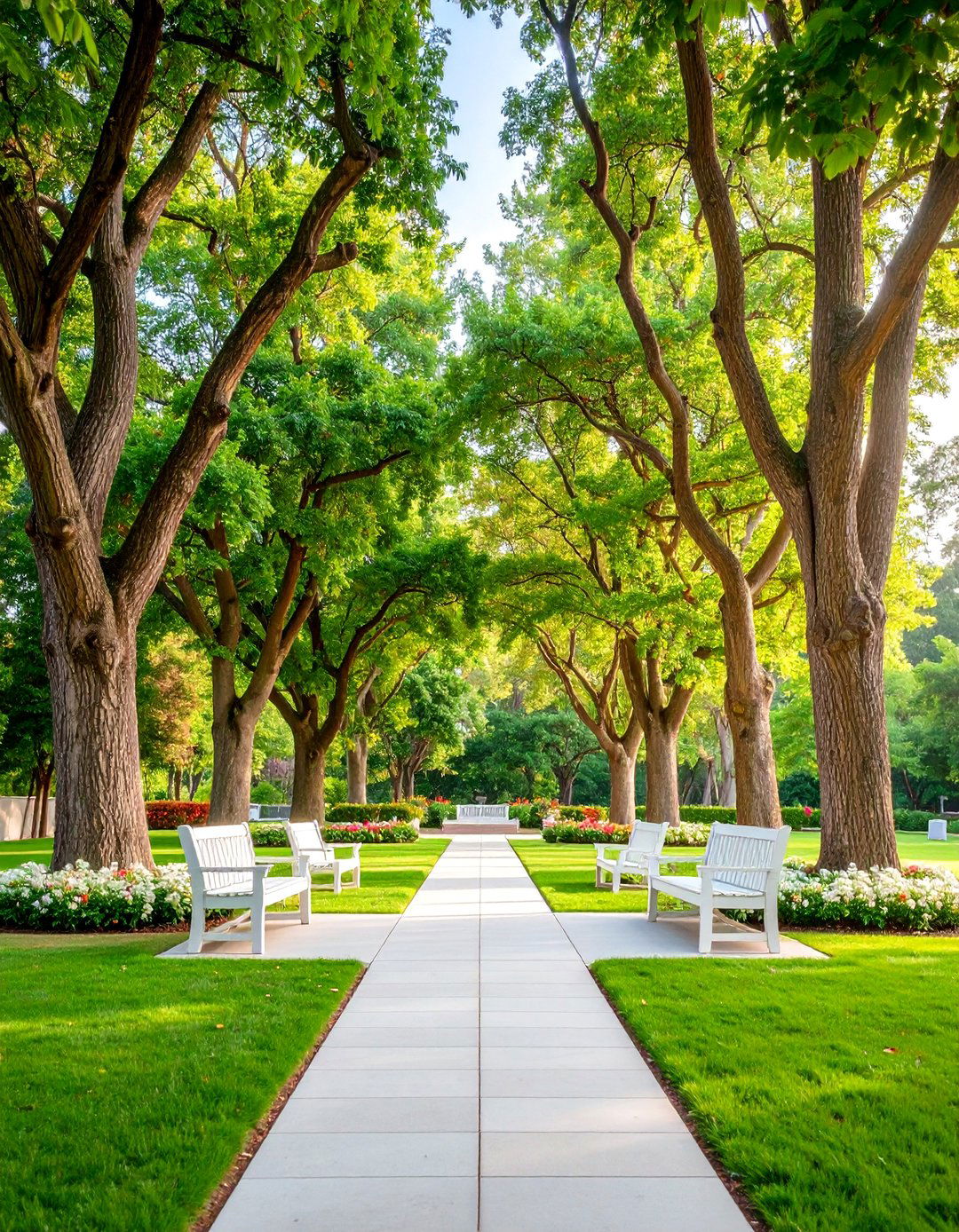
Create meaningful landscapes that honor memories while providing lasting beauty by selecting long-lived trees and designing contemplative spaces that encourage reflection and remembrance. Choose species with symbolic significance or personal meaning that will grow and mature over decades, creating living monuments that improve with age. Design peaceful settings with comfortable seating positioned to appreciate tree growth and seasonal changes. Include memorial elements like plaques, stones, or garden features that complement rather than compete with natural beauty. Plant complementary perennials that provide ongoing color and interest while requiring minimal maintenance. This deeply personal approach creates landscapes that serve both emotional and aesthetic purposes.
24. Storm-Resistant Coastal Tree Barriers
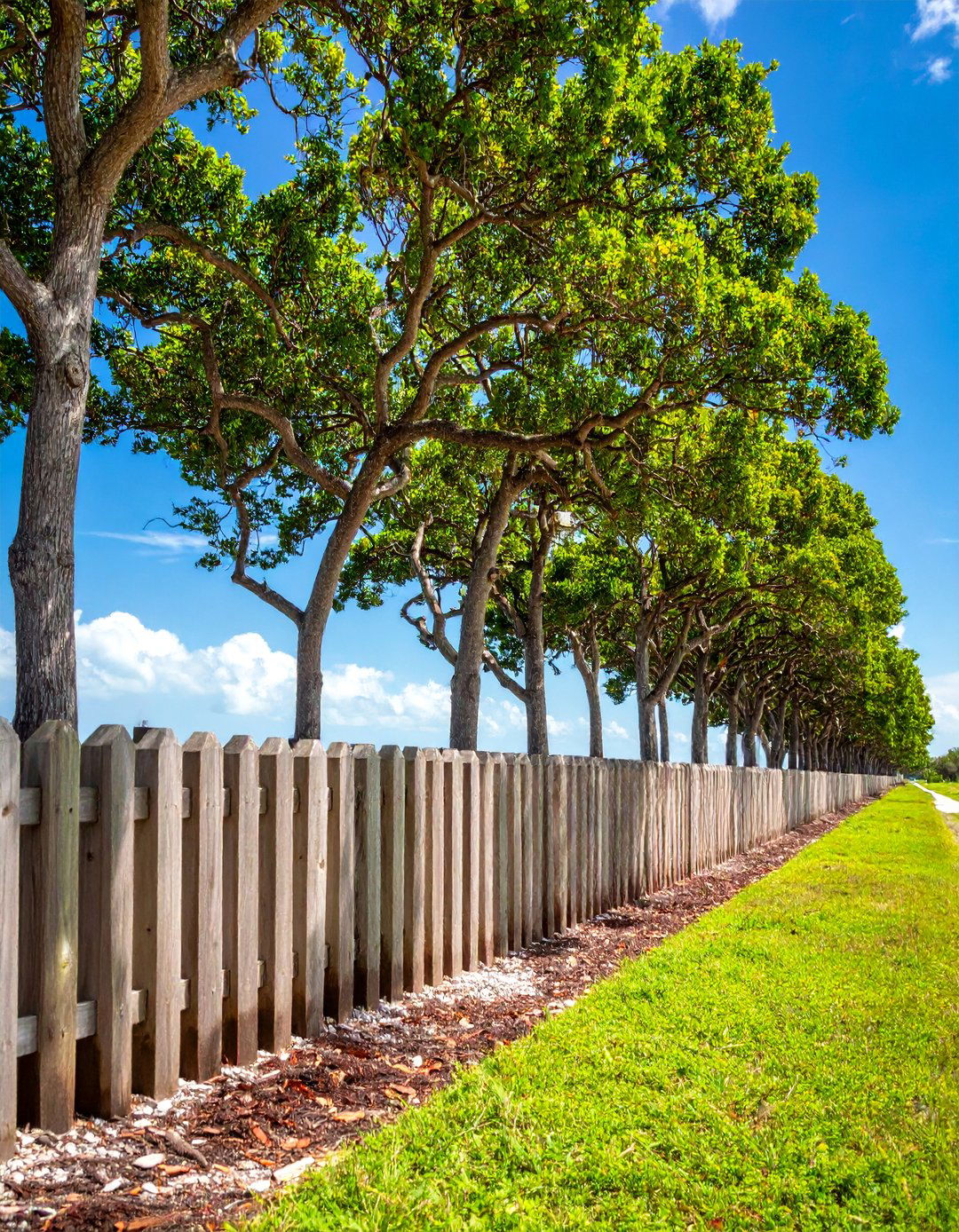
Design resilient landscapes for coastal properties using salt-tolerant trees that withstand wind, salt spray, and storm conditions while providing protection and beauty in challenging environments. Select hardy species like live oak, bald cypress, or native pines that naturally resist coastal stresses and plant them in layered arrangements for wind protection. Include salt-tolerant understory plants and design drainage solutions for storm water management. Use native materials for pathways and structures that complement the coastal environment. This practical approach creates landscapes that enhance property protection while celebrating coastal ecology and providing sustainable solutions for challenging growing conditions.
25. Container Tree Mobile Gardens

Maximize flexibility in small spaces or rental properties by growing trees in large containers that allow rearrangement, seasonal displays, and portability while providing many benefits of permanent plantings. Select appropriate dwarf varieties or slow-growing species that adapt well to container culture and design attractive groupings that can be modified as needs change. Include wheeled bases for easy movement and design irrigation systems that accommodate container growing requirements. Use containers as design elements that complement outdoor furniture and architectural features. This adaptable approach allows tree enjoyment in situations where permanent planting isn't possible while maintaining design flexibility and seasonal versatility.
Conclusion:
Tree landscaping offers endless possibilities for creating beautiful, functional outdoor spaces that provide environmental benefits while enhancing property value and quality of life. From formal designs to naturalistic arrangements, trees serve as fundamental landscape elements that provide structure, seasonal interest, and habitat value. Success depends on selecting appropriate species for local conditions and designing cohesive themes that integrate trees with complementary plantings and hardscape features. Whether seeking privacy, shade, ornamental beauty, or productive harvests, thoughtful tree placement creates landscapes that mature gracefully while requiring reasonable maintenance. These diverse approaches demonstrate that every property can benefit from strategic tree landscaping.


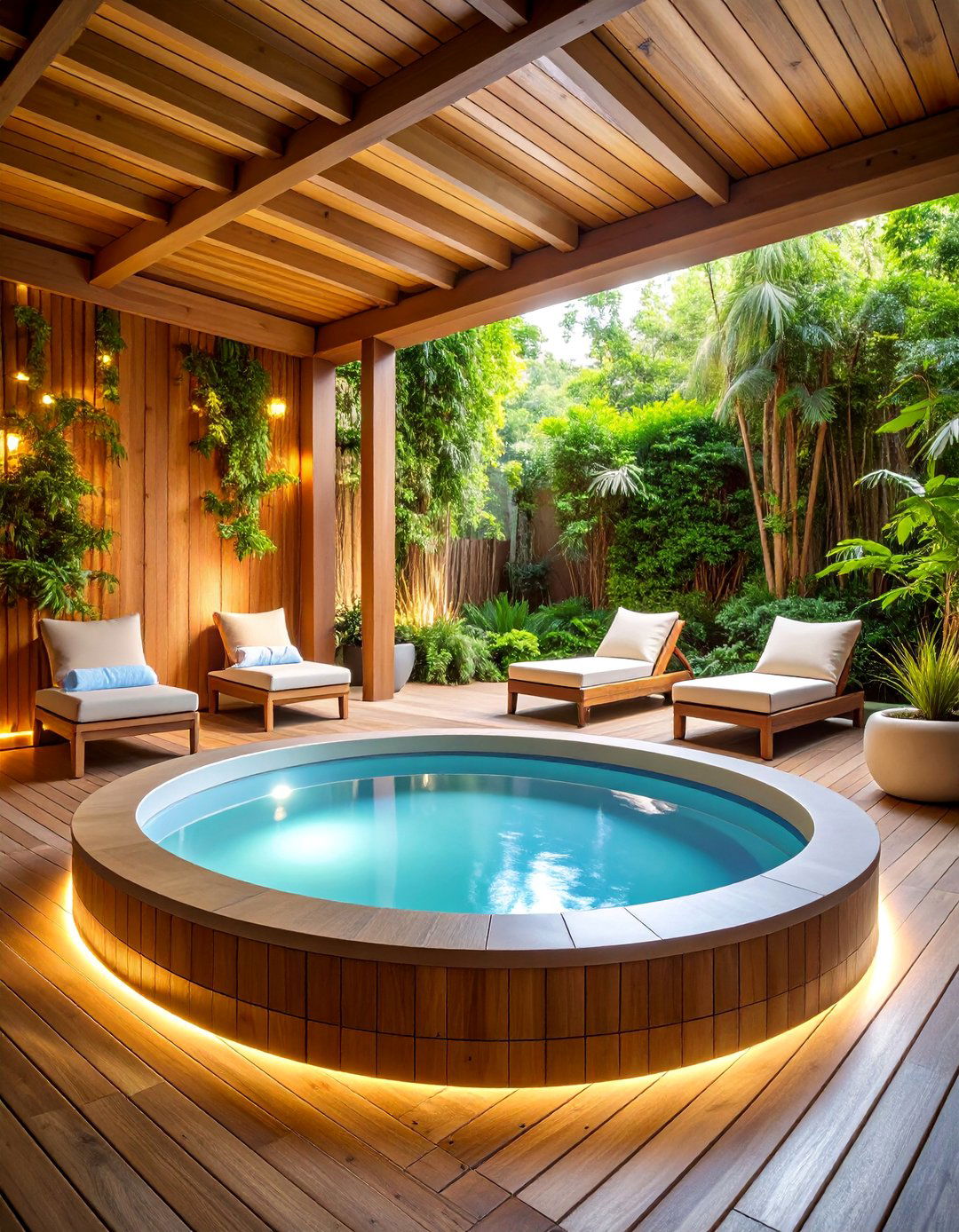
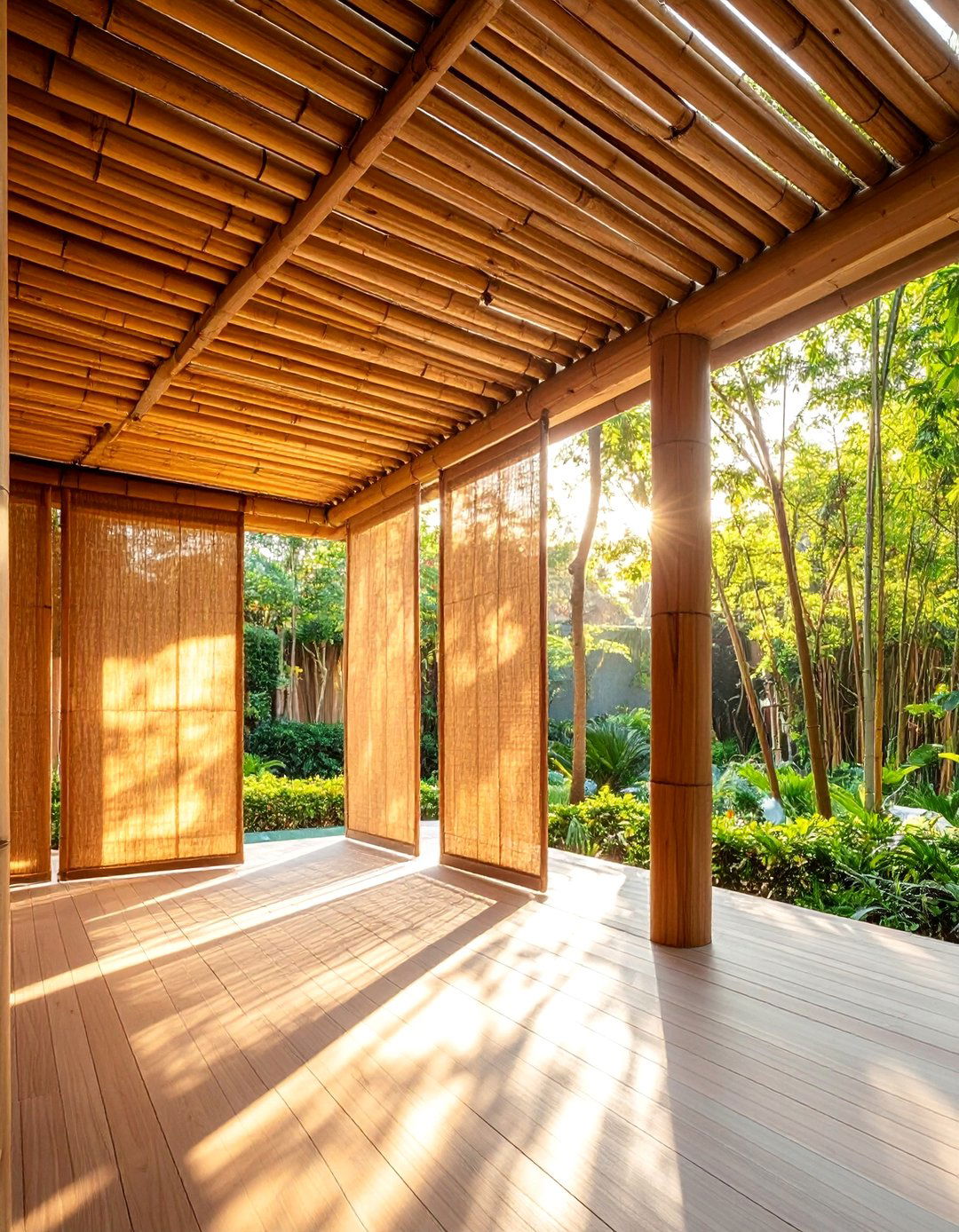

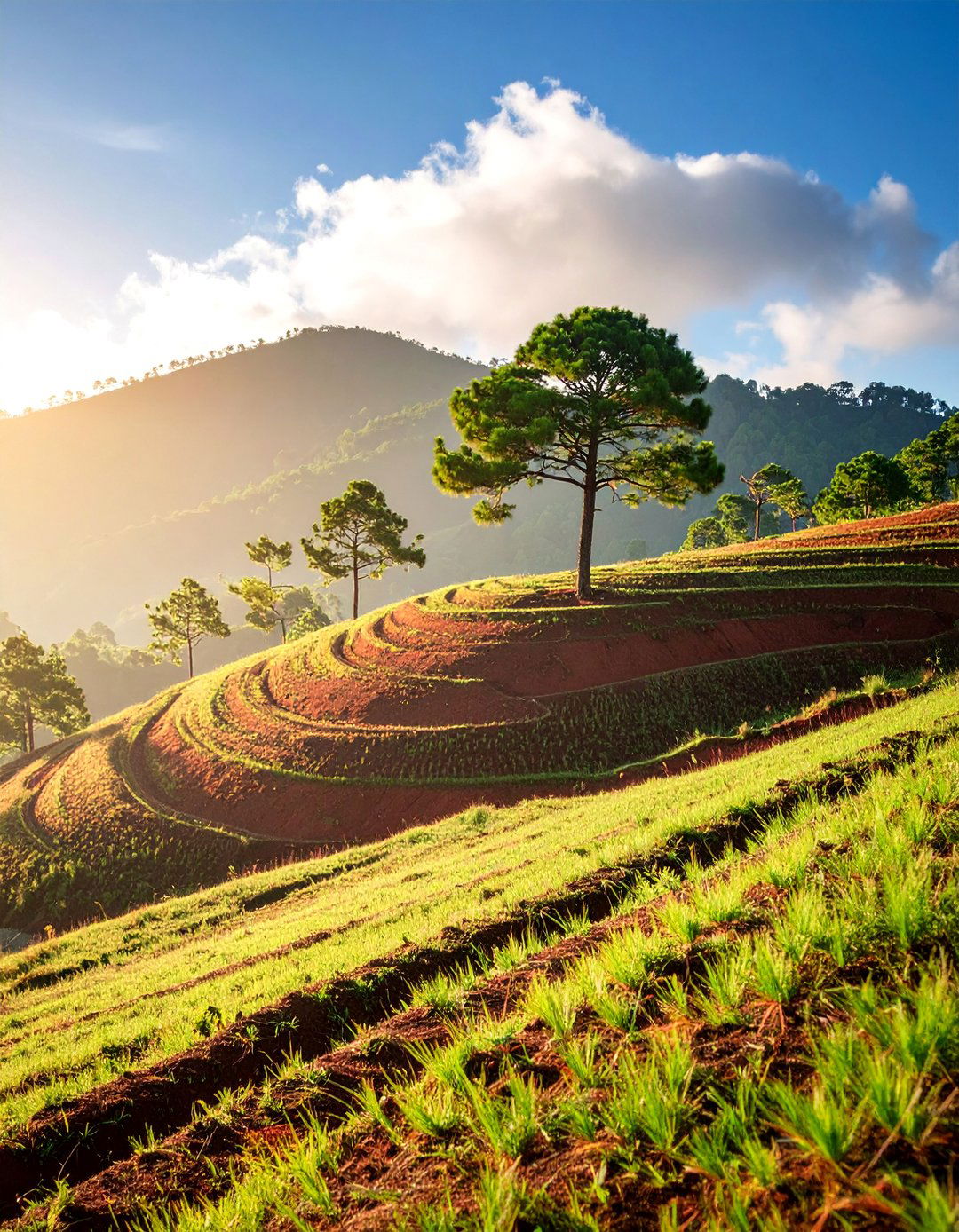
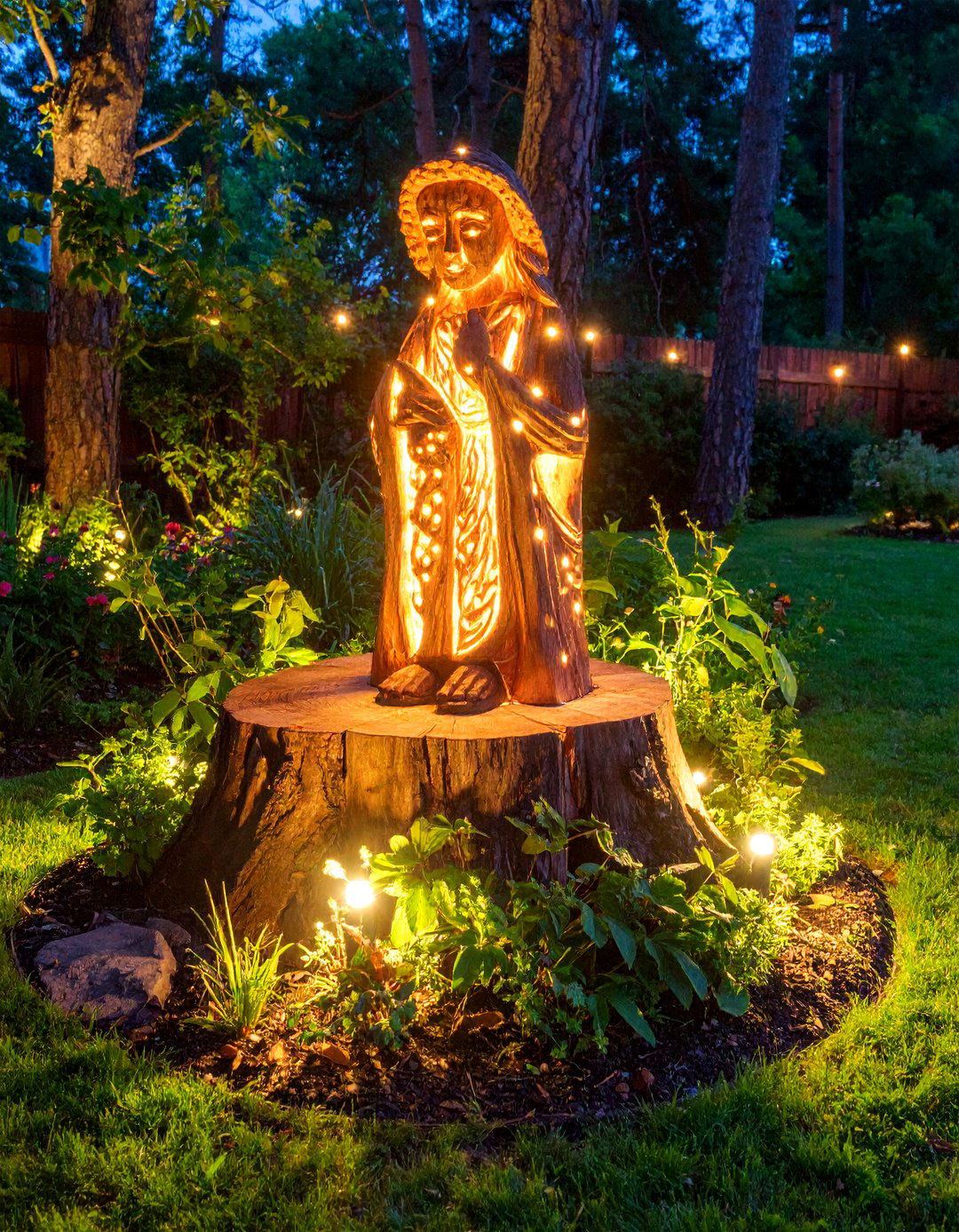



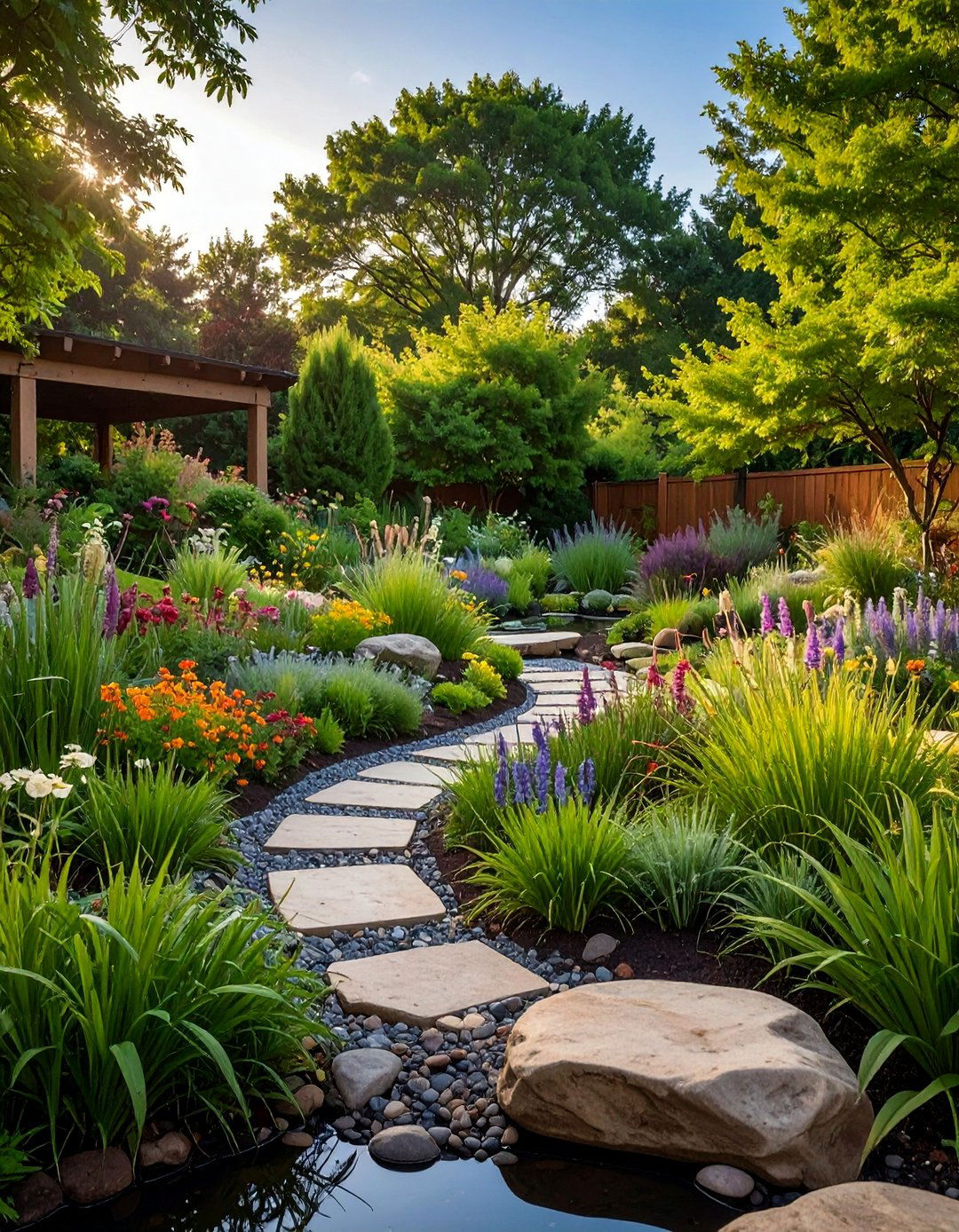
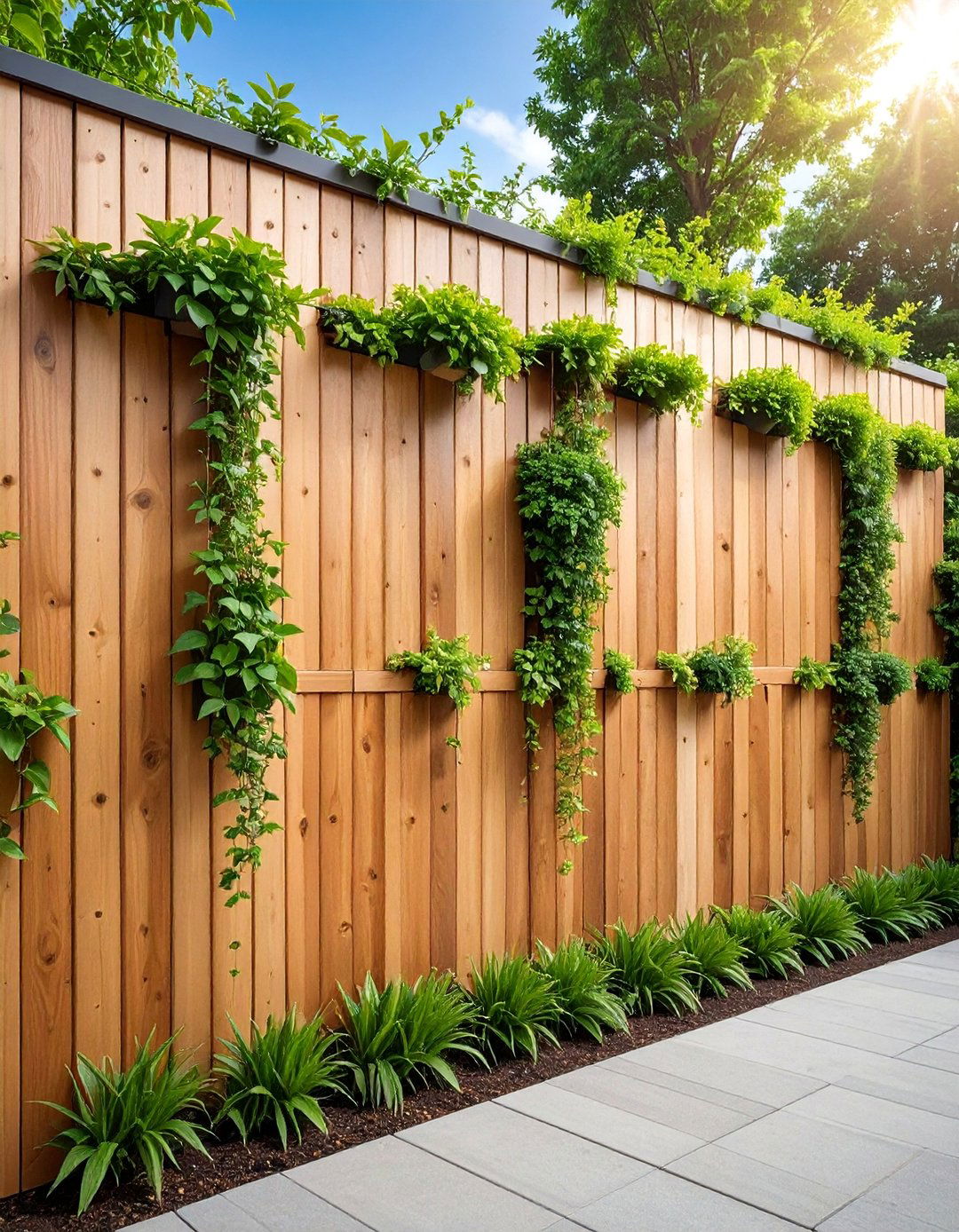
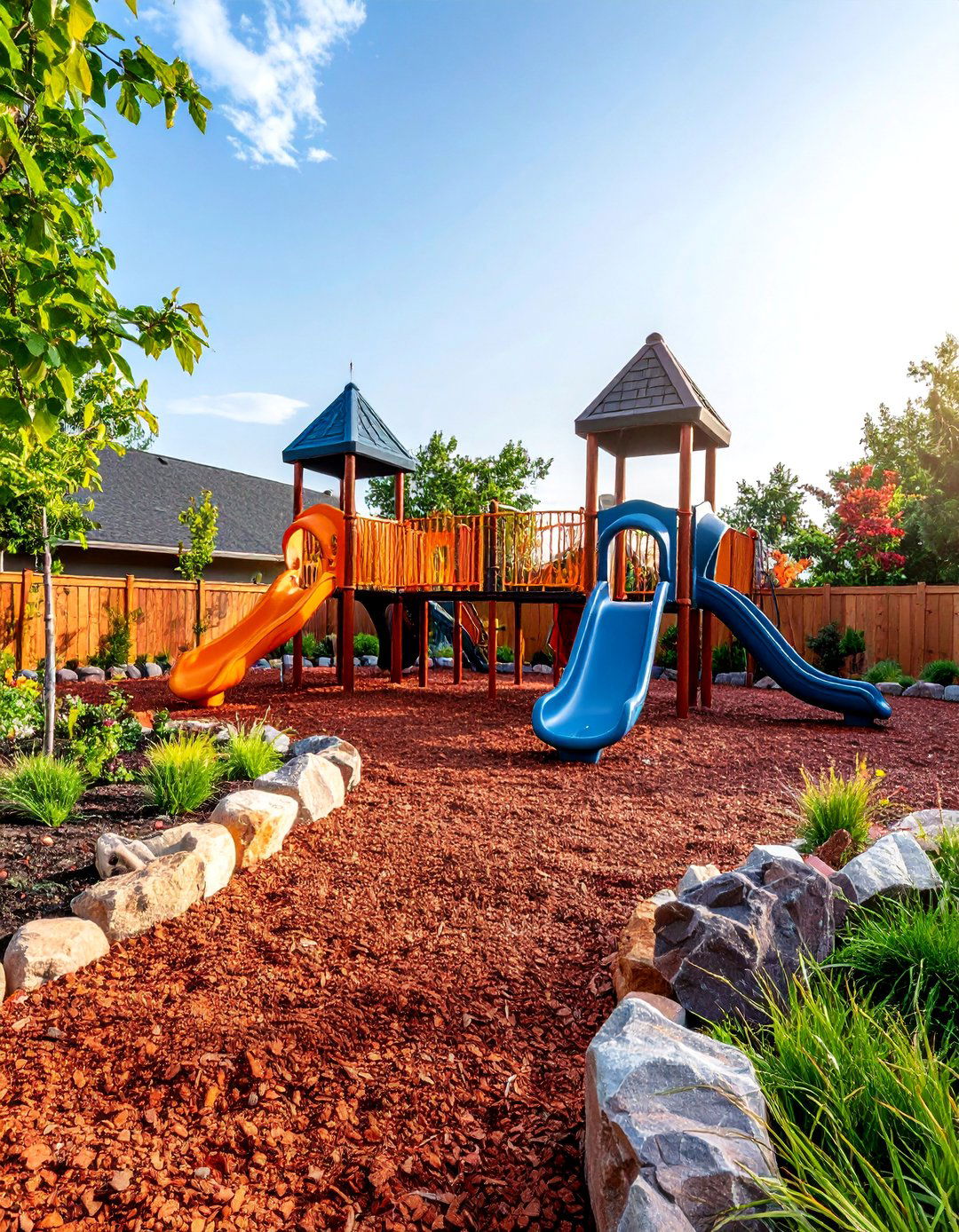
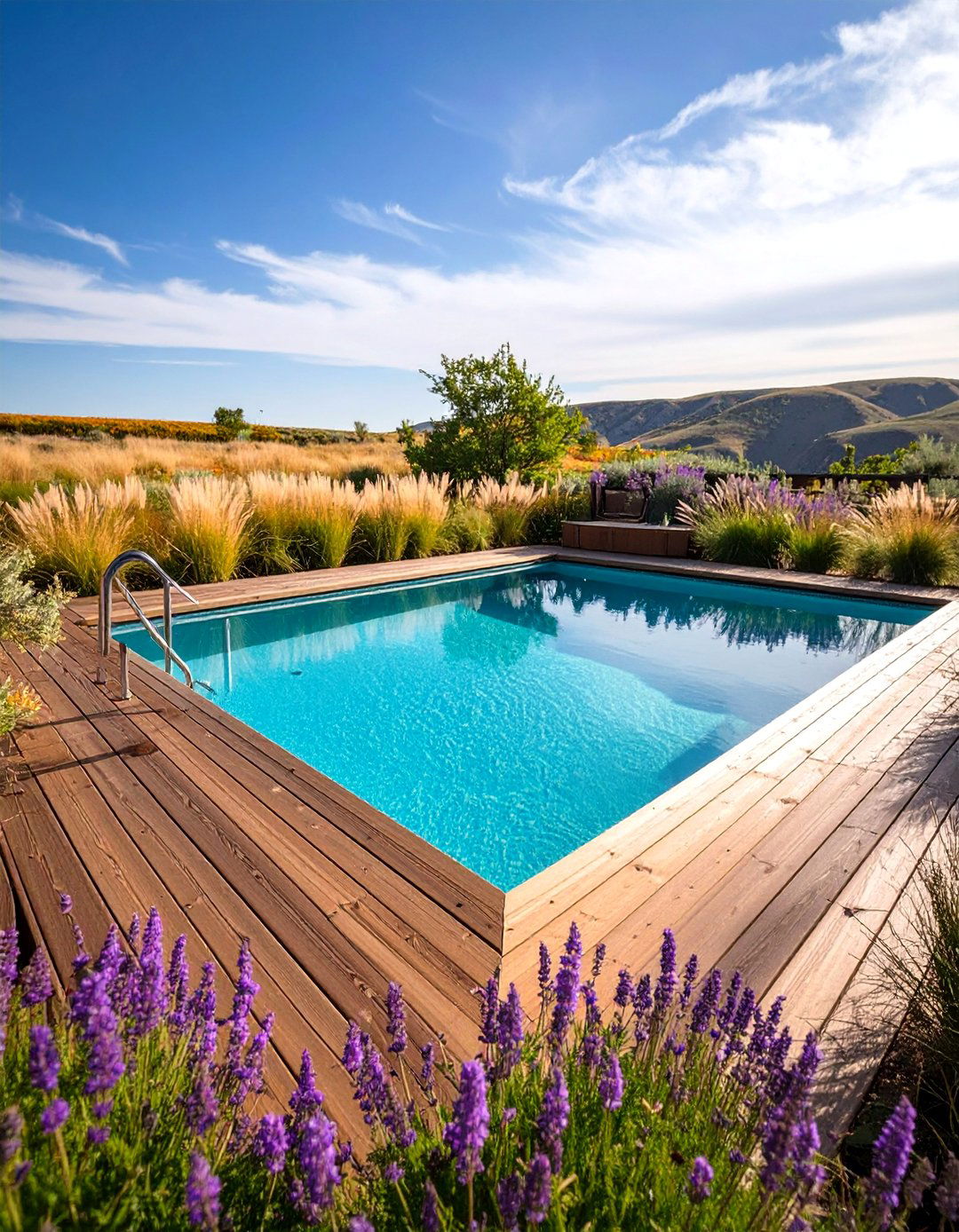
Leave a Reply